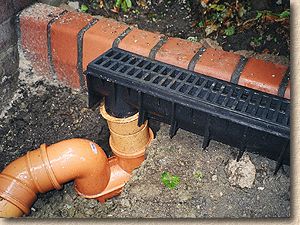Page 1 of 1
Posted: Tue Jan 25, 2005 6:32 pm
by GaryN
Tony,
I'm going to be block paving a drive in the near future which involves installing some Aco linear drainage channels.
The channels will run across the drive. The pipework will then need to run off at a 90 degree angle from the channels to a gulley about 7 metres away. I plan to connect a trap to the bottom outlet of the Aco and then a 90 degree angle. From here I'll fit a rodding point and the pipework to the gulley. The pipework will be encased in concrete as it won't be very deep. Does this sound about right? Also, how close should I be looking at putting the rodding point to the trap and are the Aco 'Raindrains' suitable for domestic driveways?
Regards
Gary
Posted: Tue Jan 25, 2005 7:02 pm
by GaryN
On second thoughts, am I right in thinking an access chamber would be the appropriate fitting as opposed to a rodding eye?
Regards
Gary
Posted: Thu Feb 03, 2005 11:45 pm
by Tony McC
Have you read the Installing Aco Drive Drain page?
This follows the installation of a very similar projecct, including the use of a small AC built into an existing pipeline.
Posted: Fri Feb 04, 2005 6:57 pm
by GaryN
Had a read, that makes things clear thanks. Just a further question for you; when placing the movement joint within the concrete encasing the pipework you mention placing this upstream of the joints. What's the theory behind this?
Regards
Gary
Posted: Fri Feb 04, 2005 7:31 pm
by Tony McC
Concrete encased drains need to be able to move with the ground, although such movement is usually very, very minor. If the flexing joint was downstream of the collar on a clayware or other rigid pipe, it would require the pipe to break to accommodate the movement, but, by placing the joint upstream, there is, apparently, less risk of the pipe breaking because there's a degree of 'accomodation' within the collar/spigot arrangement.....

Posted: Sun Feb 06, 2005 8:03 pm
by GaryN
Many thanks
Regards
Gary
Posted: Mon Feb 07, 2005 10:46 pm
by GaryN
Tony,
Okay, here's plan 'B' !
At the end of my proposed run of linear drainage channels is a small clay access chamber(?). I've lifted the cover and just one pipe runs through it (open channel as it runs through the chamber). There's no other inlets in the chamber and the chamber is less than 600mm deep. It's positioned on a bend in the clay pipe so I'm presuming the bend is why the chamber is there.
I've run water into a nearby guttering downpipe and there were no signs of the water in the chamber. However, when I run the kitchen sink taps water appeared so it would appear to be a foul water pipe only. I'm thinking of connecting my linear channels into this pipe. Would it make any difference if the pipe is thinwall clay or the thicker walled variety which I believe is the older type? I plan to replace the access chamber with a new shallow access chamber with an additional inlet for my pipework from the linear drainage. The new access chamber will only be about 1.5 to 2 metres from the linear channel outlet and I've been told I would need to use a sump unit with foul air trap. Could I get away with a normal trap fitting connected to the linear channel outlet as this would be considerably cheaper?
Regards,
Gary
Posted: Tue Feb 08, 2005 4:43 pm
by GaryN
Forgot to mention, I plan to cut out a section of the clay pipe and then fit the access chamber which will be plastic as will the additional pipework and fittings.
Regards
Gary
Posted: Thu Feb 10, 2005 4:08 pm
by Tony McC
Yes - you MUST trap the connection to the linear channel. The simplest way to achieve this is as shown here...

Posted: Wed Feb 16, 2005 5:18 pm
by GaryN
Many thanks

